
© Solvin Zankl
A legend seems to have come to life in Lake Stechlin: since the turn of the year 2019/2020, the clear water lake north of Berlin has been dominated by the algae species Planktothrix rubescens, also known as the burgundy blood alga. During thermal stratification in summer, this purple-reddish microorganism lives in the deeper layers of the lake. When full circulation is restored in autumn, during mild winters (without ice cover) and in spring, Planktothrix rubescens is distributed throughout the water column.
This is reminiscent of the legend of the Red Rooster in Lake Stechlin. It sits at the bottom of the lake, but when provoked, it rises, red and angry, and beats the lake with its wings until it foams and surges, taking everything on the surface down with it (as described in Theodor Fontane’s “Wanderungen aus der Mark Brandenburg” (Ramblings through Brandenburg)). Fortunately, this has not yet happened in the real Lake Stechlin. Planktothrix rubescens is a cyanobacteria species and an important component of phytoplankton – the primary producers in aquatic ecosystems. “We can see the long, relatively thin filaments of Planktothrix rubescens immediately after sampling Lake Stechlin by using new analytical methods such as image-based flow cytometry,” reported Stella Berger, phytoplankton ecologist at IGB.

The red cell filaments of Planktothrix rubescens next to Pandorina sp., a green alga. | © Kreinitz
“Algae” is more of a collective term (from the Latin alga). It is used to refer to a variety of eukaryotic (nucleated) organisms, most of which live in water and carry out photosynthesis, producing about half of the oxygen in the Earth’s atmosphere. Algae can be divided into two groups based on size: microalgae and macroalgae. Microalgae are microscopically small, mostly single-celled species, but they can also form colonies and long filaments. As primary producers, they are at the base of the aquatic food web. Cyanobacteria also play a role in the food web, but are procaryotes (single-celled organism whose cell lacks a nucleus and other membrane-bound organelles). Like other microalgae, they can be ingested by zooplankton. Macroalgae (large algae) are visible to the naked eye and range in length from a few millimetres to 60 metres. Most macroalgae live in the sea (kelp). Stoneworts are an example of freshwater macroalgae. They provide shelter and habitat for a variety of aquatic organisms, such as juvenile fish and small crustaceans.
The problem of algal blooms
Algae become a problem when they suddenly multiply very rapidly, resulting in so-called algal blooms. The main cause of this rapid growth is nutrients, especially phosphorus. These nutrients are discharged into water bodies, for example from agriculture or municipal sewage. Heat also plays an important role, as many algae prefer warm water. “But heat is not the only decisive factor,” stated Karla Münzner, who conducts research into plankton ecology at IGB. It is therefore difficult to say to what extent human-induced global warming is responsible for the mass development of algae. Heavy rainfall events, which are increasing as a result of climate change, also contribute to algae growth by washing more nutrients from the environment into the water. Strong storms in summer are another factor, as they stir up nutrients from the depths into the upper layer of water, where most algae are found. In addition, recent results from IGB researchers show that cyanobacteria also thrive at low temperatures (below 15°C), even in winter under ice and snow. “This means that cyanobacteria can adapt very quickly to changing environmental conditions,” summarised Stella Berger.
Cyanobacterial blooms have a negative impact on the ecosystem: other species of algae are displaced or inhibited by a lack of resources (light, nutrients), and when the dead organisms are decomposed by bacteria after an algal bloom, oxygen consumption and oxygen deficiency can occur. This then affects animals such as fish, mussels and insects. Metabolites or toxins produced by cyanobacteria can have negative effects on fish and other species such as mussels, or on certain zooplankton that feed directly on the algae. For humans, massive growth of algae means that we can no longer use a lake as we would normally: for swimming, angling or letting our dogs bathe. Although waterworks can filter cyanobacteria out of drinking water, the cost of doing so has to be borne by the public.
Previously neglected factors may also contribute to the growth of cyanobacteria. For example, they benefit indirectly from compounds leached from cigarette butts. These include metals and nicotine, which can inhibit the infection of cyanobacteria by parasitic chytrid fungi. “This inhibition in turn indirectly promotes the growth of cyanobacteria, revealing previously unknown ecological effects of cigarette waste on the aquatic environment,” explained Erika Martinez-Ruiz from the Disease Evolutionary Ecology research group at IGB.
Algal blooms are not only caused by cyanobacteria. Diatoms, which prefer cooler temperatures and act as a food source for zooplankton, especially in spring, can also proliferate in large numbers if sufficient nutrients are available. These blooms are part of the natural plankton succession and form a so-called spring bloom in many lakes which are usually short-lived as they are either attacked by fungi, sink as aggregates or are consumed by zooplankton.
The best way to prevent unwanted algal blooms is to reduce nutrient inputs. “Agriculture is an important driving force. There are many things that can be done in this area, such as choosing the right fertiliser and adjusting the amount, dosage and timing, i.e. how often and when it is applied: for example, fertiliser should not be applied shortly before the arrival of a rain front,” said Karla Münzner. Vegetated buffer strips between fields and water bodies can bind a large proportion of nutrients. It can also help to introduce aquatic plants, which take away some of the light needed by algae and reduce nutrients, or to plant trees along the banks to provide shade.
New insights into golden algae in the Oder River
_0.jpg)
Several prymnesium cultures (here the UTEX 2979 strain from Texas) grow in the laboratory under controlled conditions. Researchers are studying how different salt and nutrient concentrations affect growth. The algae strains can also be sequenced for genetic analysis and used for toxicity tests. | © David Ausserhofer/IGB
The major fish kill in the Oder River in the summer of 2022 demonstrated the potential impact of toxic algae on a river ecosystem. According to IGB research, the golden algae Prymnesium parvum proliferated there again in 2024. “This was due to similar conditions as in 2022: there are still a lot of nutrients in the Oder, and the conductivity, i.e. the salt content, increased again. The big difference to 2022 was that the river was flowing faster,” remarked Karla Münzner. The researchers have not yet found out why the algae were not toxic this year. “We suspect that they were less stressed in 2024,” stated the biologist. New insights into the golden algae are also provided by the decoding of its entire genetic material, the genome. In the genome sequence of the type of algae found in the Oder River, an IGB team has identified genes that play an important role in toxin production. On this basis, Karla Münzner can carry out laboratory tests to determine whether these genes show increased activity when the algae produce their toxins (prymnesins), or under which conditions the activity is low or no toxin is produced. These findings could also contribute to an early warning system for future blooms.
Tracking down toxic cyanobacteria on water plants in Lake Tegel
Toxic organisms are also the focus of a team led by Sabine Hilt, which is exploring cyanobacteria-covered aquatic plants in Lake Tegel, north of Berlin. Since 2017, several dogs have died there after coming into contact with water moss that was washed ashore. “It was covered with cyanobacteria, which are not suspended in the water,” reported Sabine Hilt. The water moss has no firm roots and can drift. It was the toxin anatoxin produced by the cyanobacteria that killed the dogs.
At first it was thought to be a random, one-off phenomenon. But the toxic cyanobacteria on the aquatic plants have appeared every year since, and some shores of Lake Tegel have even had to be temporarily closed. In a joint project involving experts from the Federal Environment Agency, Technische Universität Berlin and the Leibniz Research Centre for Working Environment and Human Factors, Sabine Hilt wants to investigate the ecology of the organisms that grow on the plants and clarify the conditions that lead to the emergence of plant-associated toxic cyanobacteria in lakes. “Our aim is to enable better risk assessment. We are also gathering information on this little-studied association, which has also been found in other countries,” she stated.
What seems clear so far is that there are several variants of these cyanobacteria with different toxin patterns. Hotspots are also formed in the lake: “The toxic biofilm is not evenly distributed in a lake, there are places with high concentrations,” explained Sabine Hilt. This makes monitoring and sampling more difficult because even if no toxic material is found in one place, the situation may be completely different a few metres away.
Potential use of cyanobacteria
“Whether there will be more cyanobacterial blooms in the future or whether such blooms will decrease due to improved management of water bodies and their catchments is currently under discussion,” commented Stella Berger. There is general agreement that increased nutrient inputs and warming waters favour the development of cyanobacterial blooms, which can be toxic. In addition to climate change, the rapid growth of the world’s population also plays a role. However, there are also some positive prospects: novel concepts for the use of cyanobacteria in the field of cancer research are currently being investigated. “We also need innovative and solution-oriented projects in the field of freshwater ecology to preserve our water bodies for future generations,” stated Stella Berger.











